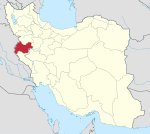Kangavar
Kangavar
Persian: كنگاور | |
|---|---|
City | |
| Coordinates: 34°30′04″N 47°57′28″E / 34.50111°N 47.95778°E[1] | |
| Country | Iran |
| Province | Kermanshah |
| County | Kangavar |
| District | Central |
| Population (2016)[2] | |
• Total | 51,352 |
| Time zone | UTC+3:30 (IRST) |
Kangavar (Persian: كنگاور)[a] is a city in the Central District of Kangavar County, Kermanshah province, Iran, serving as capital of both the county and the district.[4]
Kangavar is in the easternmost part of Kermanshah province, on the modern road from Hamadan to Kermanshah, identical with a trace of the Silk Road, located at the distance of about 75 km from Hamadan and 96 km from Kermanshah.[5]
History
[edit]Kangavar was mentioned by Isidore of Charax in the 1st century AD, by the name of "Konkobar" or "Concobar" (Greek: Κογκοβάρ) in the ancient province of Ecbatana (modern Hamedan).[6] In antiquity, the city was in Media, with a temple of Artemis (Isidor. Char. p. 7; Tab. Pent.; Geogr. Rav.)[7]
In the early 20th century, Kangavar was held in fief by the family of a deceased court official, forming a separate government.[citation needed]

Today, the town is best known for the archaeological remains of a mixed Sassanid and Achaemenid-style edifice.[8] During the 19th century and the beginning of the 20th century, the ruins were misused as a source for building material for the expanding town.[9] Excavation first began in 1968, by which time the "large structure with its great columns set on a high stone platform"[10] had been associated with a comment by Isidore of Charax, that refers to a "temple of Artemis" (Parthian Stations 6) at "Concobar" in Lower Media, on the overland trade route between the Levant and India. References to Artemis in Iran are generally interpreted to be references to Anahita, and thus Isidore's "temple of Artemis" came to be understood as a reference to a temple of Anahita.[citation needed]
Although a general plan of the complex has been compiled, it is still not sufficient to learn about the function and shape of the terrace and the buildings that stood there. Given the lack of archaeological evidence for a temple-like building, "it is questionable whether the [temple noted by Isodore] is identical with the ruins of Kangavar. Isidorus described obviously another temple of the first century AD, somewhere in the region of Congobar (Kangavar) or at the place of the later platform, which, according to the results of the excavation, seems to be built up in Sasanian times."[9]
Demographics
[edit]Population
[edit]At the time of the 2006 National Census, the city's population was 48,901 in 12,220 households.[11] The following census in 2011 counted 53,449 people in 15,021 households.[12] The 2016 census measured the population of the city as 51,352 people in 15,762 households.[2]
See also
[edit]Notes
[edit]References
[edit]- ^ OpenStreetMap contributors (14 July 2023). "Kangavar, Kangavar County" (Map). OpenStreetMap (in Persian). Retrieved 14 July 2023.
- ^ a b "Census of the Islamic Republic of Iran, 1395 (2016)". AMAR (in Persian). The Statistical Center of Iran. p. 05. Archived from the original (Excel) on 3 April 2022. Retrieved 19 December 2022.
- ^ Kangavar can be found at GEOnet Names Server, at this link, by opening the Advanced Search box, entering "-3069549" in the "Unique Feature Id" form, and clicking on "Search Database".
- ^ Habibi, Hassan (21 June 1369). "Approval of the organization and chain of citizenship of the elements and units of the national divisions of Bakhtran province, centered in the city of Bakhtran". Research Center of the System of Laws of the Islamic Council of Farabi Mobile Library (in Persian). Ministry of Interior, Defense Political Commission of the Government Board. Archived from the original on 6 February 2013. Retrieved 29 January 2024.
- ^ Wolfram Kleiss, "Kangavar", Encyclopaedia Iranica; accessed 31 October 2021.
- ^ "Temple of Anahita at Kangavar". Archived from the original on 1 November 2009. Retrieved 18 November 2009.
- ^
 This article incorporates text from a publication now in the public domain: Smith, William, ed. (1854–1857). "Concobar". Dictionary of Greek and Roman Geography. London: John Murray.
This article incorporates text from a publication now in the public domain: Smith, William, ed. (1854–1857). "Concobar". Dictionary of Greek and Roman Geography. London: John Murray.
- ^ "Konkobar (Kangavar)". Archived from the original on 25 March 2015. Retrieved 26 March 2020.
- ^ a b Kleiss 2005.
- ^ Kawami 1987:326.
- ^ "Census of the Islamic Republic of Iran, 1385 (2006)". AMAR (in Persian). The Statistical Center of Iran. p. 05. Archived from the original (Excel) on 20 September 2011. Retrieved 25 September 2022.
- ^ "Census of the Islamic Republic of Iran, 1390 (2011)". Syracuse University (in Persian). The Statistical Center of Iran. p. 05. Archived from the original (Excel) on 18 January 2023. Retrieved 19 December 2022.
Bibliography
[edit]- Huff, D. (1987), "Architecture: Sasanian", Encyclopaedia Iranica, vol. 2, New York: Routledge & Kegan Paul, pp. 329–334
- Kawami, T. (1987), "Architecture: Seleucid", Encyclopaedia Iranica, vol. 2, New York: Routledge & Kegan Paul, pp. 326–327
- Keall, E. J. (1987), "Architecture: Parthian", Encyclopaedia Iranica, vol. 2, New York: Routledge & Kegan Paul, pp. 327–329
- Kleiss, Wolfram (2005), "Kangāvar", Encyclopaedia Iranica, vol. OT 7, Costa Mesa: Mazda


